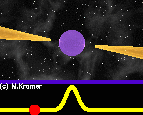Under the proper circumstances, the magnetic field of a rotating neutron star interacts with the surrounding cloud of matter in a way that makes the neutron star send out a highly focussed beam of radio waves which, like the beam of a light-house, is in constant motion (see animation left). If, in the course of one rotation, this beam is directed at the Earth, terrestrial astronomers observe a pulsar - a neutron star from which they receive a regular succession of radio pulses. As neutron stars are massive and comparatively rigid, their rotation is very regular, and consequently, the pulses reaching the solar system are also of great regularity. In fact, some pulsars can be used to monitor the regularity of the rhythm of atomic clocks here on Earth!
Astrophysik: Gravitationswellen
[ Sitemap ]
[ info ] This website was created by the MPI for the History of Science.
 Scene
Scene


 1st Slide
1st Slide
 Branching Point
Branching Point
 Module: Astrophysik: Gravitationswellen
Module: Astrophysik: Gravitationswellen Sequence: Gravitationswellen Einstieg
Sequence: Gravitationswellen Einstieg Slide: Gravitational Waves
Slide: Gravitational Waves Branching Point: Gravitational waves
Branching Point: Gravitational waves Back
Back


